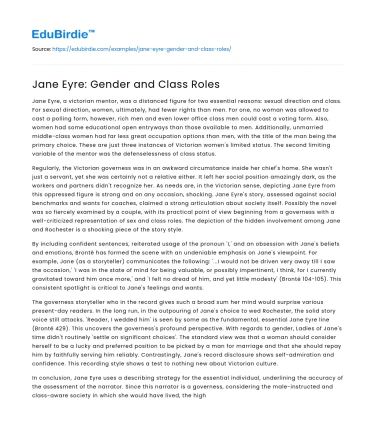Jane Eyre, a victorian mentor, was a distanced figure for two essential reasons: sexual direction and class. For sexual direction, women, ultimately, had fewer rights than men. For one, no woman was allowed to cast a polling form, however, rich men and even lower office class men could cast a voting form. Also, women had some educational open entryways than those available to men. Additionally, unmarried middle-class women had far less great occupation options than men, with the title of the man being the primary choice. These are just three instances of Victorian women's limited status. The second limiting variable of the mentor was the defenselessness of class status.
Regularly, the Victorian governess was in an awkward circumstance inside her chief's home. She wasn't just a servant, yet she was certainly not a relative either. It left her social position amazingly dark, as the workers and partners didn't recognize her. As needs are, in the Victorian sense, depicting Jane Eyre from this oppressed figure is strong and on any occasion, shocking. Jane Eyre's story, assessed against social benchmarks and wants for coaches, claimed a strong articulation about society itself. Possibly the novel was so fiercely examined by a couple, with its practical point of view beginning from a governess with a well-criticized representation of sex and class roles. The depiction of the hidden involvement among Jane and Rochester is a shocking piece of the story style.
Save your time!
We can take care of your essay
- Proper editing and formatting
- Free revision, title page, and bibliography
- Flexible prices and money-back guarantee
By including confident sentences, reiterated usage of the pronoun 'I,' and an obsession with Jane's beliefs and emotions, Brontë has formed the scene with an undeniable emphasis on Jane's viewpoint. For example, Jane (as a storyteller) communicates the following: '...I would not be driven very away till I saw the occasion,' 'I was in the state of mind for being valuable, or possibly impertinent, I think, for I currently gravitated toward him once more,' and 'I felt no dread of him, and yet little modesty' (Brontë 104-105). This consistent spotlight is critical to Jane's feelings and wants.
The governess storyteller who in the record gives such a broad sum her mind would surprise various present-day readers. In the long run, in the outpouring of Jane's choice to wed Rochester, the solid story voice still attacks. 'Reader, I wedded him' is seen by some as the fundamental, essential Jane Eyre line (Brontë 429). This uncovers the governess's profound perspective. With regards to gender, Ladies of Jane's time didn't routinely 'settle on significant choices'. The standard view was that a woman should consider herself to be a lucky and preferred position to be picked by a man for marriage and that she should repay him by faithfully serving him reliably. Contrastingly, Jane's record disclosure shows self-admiration and confidence. This recording style shows a test to nothing new about Victorian culture.
In conclusion, Jane Eyre uses a describing strategy for the essential individual, underlining the accuracy of the assessment of the narrator. Since this narrator is a governess, considering the male-instructed and class-aware society in which she would have lived, the highlight of her feelings is noteworthy. Females had fewer rights than men and governesses had unsure class and societal positions. Crediting a strong voice to such an excluded narrator makes an impression versus modern-day society. Regardless, instead of welcoming this narrative as an achievement in regards to ladies' freedom and a test to class rigidity, some significant Victorian critics criticized the novel. It is possible that these responses ended up out of undisclosed thinking, that being the clear feeling of risk to sexual orientation and class positions.






 Stuck on your essay?
Stuck on your essay?

